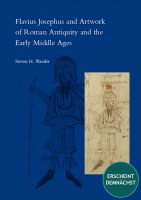Titelsuche
Flavius Josephus and Artwork of Roman Antiquity and the Early Middle Ages
Titel erscheint am 19.08.2024
17,0 x 24,0 cm, 238 S., 20 s/w Abb., 51 farb. Abb., Gebunden
ISBN: 9783752007916
17,0 x 24,0 cm, 238 S., 20 s/w Abb., 51 farb. Abb., Gebunden
129,00 €
ISBN: 9783752007916
Kurze Beschreibung
Flavius Josephus and Artwork of Roman Antiquity and the Early Middle Age demonstrates how the writings of the first-century Judaean historian influenced the genesis, nature and design of major monuments of the first millennium: 1) The frieze of the Spoils from the Temple in Jerusalem, Arch of Titus: 2) the Portrait of Josephus in Bern, Burgerbibliothek, Cod. 50, fol. 2r; 3) The Sack of Jerusalem on the Franks (Auzon) Casket 4) The Lost Portico Mosaics at S. Giovanni in Laterano, Rome; Illuminations in 5) the Christian Topography of Kosmas Indikopleustes. 6) the Codex Amiatinus; and 7) The Paris Psalter.Ausführliche Beschreibung
Flavius Josephus, historian of first-century Judaea and its past, is among the most well-studied individuals of the Ancient World: “A veritable Josephus industry has emerged, with regular international colloquia, a burgeoning number of publications, and major commentaries on individual works (and parts of works),” where “Josephus supports an entire world of research which encompasses Biblical studies, Jewish history, Hellenistic and Roman history, New Testament studies, Jewish Thought and Philosophy, Land of Israel studies, Classical languages, and of course the study of Josephus himself.” Nevertheless, artwork related to the writings of Josephus has been largely overlooked and ignored. In a 1989 review, it was recognized that “The texts, sources, and reception of Josephus have all been studied in modern times, but the pictorial tradition was neglected.” Flavius Josephus and Artwork of Roman Antiquity and the Early Middle Age seeks to remedy this situation and provide an assessment of his influence on artistic creations from the first millennium. It provides case studies for the most important art objects related to Josephus that survive from the first centuries of the Common Era or shortly thereafter and to place them, to the degree possible, in their historical situation. Although for the most part unrecognized previously, this study demonstrates in detail the influence of Flavius Josephus and his writings on the visual arts of Roman Antiquity and the Early Middle Age and his contribution to the genesis, nature and design of major masterpieces. It should be of interest to all students of Josephus and the artworks listed below.1) The frieze of the Spoils from the Temple in Jerusalem, the Arch of Titus, Rome.
2) The Portrait of Josephus, the Writer of History, in Bern, Burgerbibliothek, Cod. 50, fol. 2r.
3) The Sack of Jerusalem, the rear panel of the Franks (Auzon) Casket, British Museum.
4) The Lost Portico Mosaics at S. Giovanni in Laterano, Rome.
5) Illuminations of the Tabernacle of Moses and its furnishings in the Christian Topography of Kosmas Indikopleustes.
6) Illuminations of the Tabernacle of Moses and of Ezra in the Codex Amiatinus (Florence, Biblioteca Medicea Laurenziana, MS Amiatino 1).
7) The Paris Psalter Illuminations of the life of David (Paris, Bibliothèque nationale, cod. gr. 139).
Autoreninfo
Steven H. Wander (born 1946)Stanford University, 10/71 to 1/75, Ph.D. Art History. Doctoral Dissertation: “Westminster Abbey: A Case Study in the Meaning of Medieval Architecture.”
University of California, Berkeley, 10/68 to 12/69, M.A. Art History
Master’s Thesis: “The York Chapter House.”
University of California, Berkeley, 10/64 to 9/68, B.A. Art History
Adjunct Professor, Art History, University of Connecticut, Stamford 2002 – 2022, retired University of Connecticut, Stamford, One University Place, Stamford, CT 06901, U.S.A.
Chair, Art History, School of Fine Arts, University of California, Irvine, 1977-80 Assistant Professor, Art History, School of Fine Arts, University of California, Irvine, 1974-80
Chief Executive Officer, Wander & Company, Jewelers Inc, 1/81 – Present (retired)
Advanced Seminar in Medieval Manuscript Studies (M-90) taught by Barbara A. Shailor, Yale Beinecke Rare Book and Manuscript Library, 5-10 June 2016
$2,500 grant from the University of Connecticut, School of Fine Arts, Dean’s Creative Activity and Research Fund, 2011 for publication rights and photographs from the Biblioteca Apostolica Vaticana for The Joshua Roll (Reichert Verlag, 2012).
National Endowment for the Humanities Summer Seminar. Trajan’s Column: Narratives of War, Civilization, and Commemoration in the Roman Empire (6/26 – 7/28, 2006)
American Council of Learned Societies Grant-in-aid for Recent Ph.D. Recipients, 1977
UCLA Center for Medieval and Renaissance Studies Annual Award, 1975
Fulbright-Hays Grant for Graduate Study Abroad to the Courtauld Institute of Art, United Kingdom, 1973-74
Reihentext
Diese Schriftenreihe widmet sich speziell den Forschungen zur Christlichen Archäologie und Kunstgeschichte in spätantiker und frühchristlicher Zeit. Sie umfasst die gesamte Epoche der Spätantike bis zum frühen Mittelalter, im Bereich des byzantinischen Reiches auch darüber hinaus.
Die Reihe ist überkonfessionell und ohne Bindung an bestehende Institutionen, arbeitet jedoch mit der „Arbeitsgemeinschaft Christliche Archäologie zur Erforschung spätantiker, frühmittelalterlicher und byzantinischer Kultur“ zusammen. Sie konzentriert sich vor allem auf die Kunstdenkmäler und versteht sich daher nicht als Konkurrenz, sondern als Ergänzung zu schon bestehenden Reihen, die in der Regel nicht nur die materielle Hinterlassenschaft der alten Kirche, sondern stets auch literarische, theologische und philologische Themen behandeln.
Einer klareren Zuordnung und einer größeren Bandbreite der verschiedenen Disziplinen wegen wurden zwei Unterreihen eingerichtet:
Die Reihe A „Grundlagen und Monumente“ setzt sich schwerpunktmäßig mit einzelnen Denkmälern bzw. Denkmalgruppen im Sinne einer korpusartigen Erfassung der Denkmäler auseinander.
In der Reihe B „Studien und Perspektiven“ werden einerseits Vorträge der Tagungen der „Arbeitsgemeinschaft Christliche Archäologie“ publiziert, andererseits bietet sie ein Forum für Untersuchungen zu den verschiedensten Fragen aus dem Gebiet der spätantiken/byzantinischen Archäologie und Kunstgeschichte.




 Inhaltsverzeichnis
Inhaltsverzeichnis

 Neuerscheinungen 2023/2024
Neuerscheinungen 2023/2024
 Gesamtverzeichnis 2023/2024
Gesamtverzeichnis 2023/2024
 Katalog Oriental Studies & Linguistics
Katalog Oriental Studies & Linguistics
 Mittelalter
Mittelalter
 Deutsche Inschriften
Deutsche Inschriften
 Musiktherapie
Musiktherapie
 Literaturen im Kontext
Literaturen im Kontext